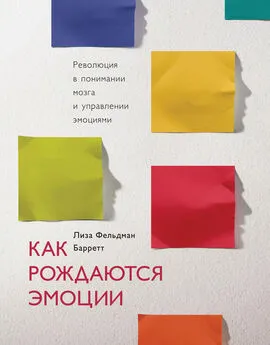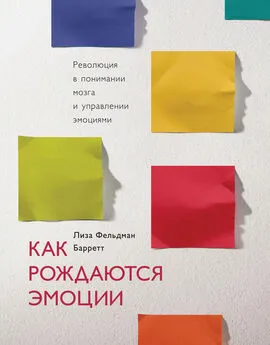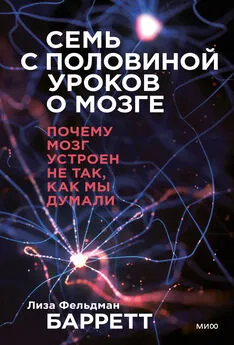Лиза Барретт - Как рождаются эмоции
- Название:Как рождаются эмоции
- Автор:
- Жанр:
- Издательство:Манн, Иванов и Фербер
- Год:2018
- Город:Москва
- ISBN:нет данных
- Рейтинг:
- Избранное:Добавить в избранное
-
Отзывы:
-
Ваша оценка:
Лиза Барретт - Как рождаются эмоции краткое содержание
Эта книга совершает революцию в понимании эмоций, разума и мозга. Вас ждет захватывающее путешествие по удивительным маршрутам, с помощью которых мозг создает вашу эмоциональную жизнь. Вы научитесь по-новому смотреть на эмоции, свои взаимоотношения с людьми и в конечном счете на самих себя. На русском языке публикуется впервые.
Как рождаются эмоции - читать онлайн бесплатно ознакомительный отрывок
Интервал:
Закладка:
Ellis, Bruce J., and W. Thomas Boyce. 2008. “Biological Sensitivity to Context.” Current Directions in Psychological Science 17 (3): 183–187.
Emmons, Robert A., and Michael E. McCullough. 2003. “Counting Blessings Versus Burdens: An Experimental Investigation of Gratitude and Subjective Well-Being in Daily Life.” Journal of Personality and Social Psychology 84 (2): 377–389.
Emmons, Scott W. 2012. “The Mood of a Worm.” Science 338 (6106): 475–476.
Ensor, Rosie, and Claire Hughes. 2008. “Content or Connectedness? Mother-Child Talk and Early Social Understanding.” Child Development 79 (1): 201–216.
Epley, Nicholas, Adam Waytz, and John T. Cacioppo. 2007. “On Seeing Human: A Three-Factor Theory of Anthropomorphism.” Psychological Review 114 (4): 864–886.
Erbas, Yasemin, Eva Ceulemans, Johanna Boonen, Ilse Noens, and Peter Kuppens. 2013. “Emotion Differentiation in Autism Spectrum Disorder.” Research in Autism Spectrum Disorders 7 (10): 1221–1227.
Erbas, Yasemin, Eva Ceulemans, Madeline Lee Pe, Peter Koval, and Peter Kuppens. 2014. “Negative Emotion Differentiation: Its Personality and Well-Being Correlates and a Comparison of Different Assessment Methods.” Cognition and Emotion 28 (7): 1196–1213.
Erickson, Kirk I., Michelle W. Voss, Ruchika Shaurya Prakash, Chandramallika Basak, Amanda Szabo, Laura Chaddock, Jennifer S. Kim, Susie Heo, Heloisa Alves, and Siobhan M. White. 2011. “Exercise Training Increases Size of Hippocampus and Improves Memory.” Proceedings of the National Academy of Sciences 108 (7): 3017–3022.
Ernst, Aurélie, and Jonas Frisén. 2015. “Adult Neurogenesis in Humans-Common and Unique Traits in Mammals.” PLOS Biology 13 (1): e1002045. doi:10.1371/journal.pbio.1002045.
ESPN. 2014. “Bucks Hire Facial Coding Expert.” December 27. http://espn.go.com/nba/story/_/id/12080142/milwaukee-bucks-hire-facial-coding-expert-help-team-improve.
Etkin, Amit, and Tor D. Wager. 2007. “Functional Neuroimaging of Anxiety: A Meta-Analysis of Emotional Processing in PTSD, Social Anxiety Disorder, and Specific Phobia.” American Journal of Psychiatry 164 (10): 1476–1488.
Fabre-Thorpe, Michèle. 2010. “Concepts in Monkeys.” In The Making of Human Concepts , edited by Denis Mareschal, Paul C. Quinn, and Stephen E. G. Lea, 201–226. New York: Oxford University Press.
Fachner, George, Steven Carter, and Collaborative Reform Initiative. 2015. “An Assessment of Deadly Force in the Philadelphia Police Department.” Washington, DC: Office of Community Oriented Policing Services.
Feigenson, Lisa, and Justin Halberda. 2008. “Conceptual Knowledge Increases Infants’ Memory Capacity.” Proceedings of the National Academy of Sciences 105 (29): 9926–9930.
Feinstein, Justin S., Ralph Adolphs, Antonio Damasio, and Daniel Tranel. 2011. “The Human Amygdala and the Induction and Experience of Fear.” Current Biology 21 (1): 34–38.
Feinstein, Justin S., David Rudrauf, Sahib S. Khalsa, Martin D. Cassell, Joel Bruss, Thomas J. Grabowski, and Daniel Tranel. 2010. “Bilateral Limbic System Destruction in Man.” Journal of Clinical and Experimental Neuropsychology 32 (1): 88–106.
Felitti, Vincent J., Robert F. Anda, Dale Nordenberg, David F. Williamson, Alison M. Spitz, Valerie Edwards, Mary P. Koss, and James S. Marks. 1998. “Relationship of Childhood Abuse and Household Dysfunction to Many of the Leading Causes of Death in Adults: The Adverse Childhood Experiences (ACE) Study.” American Journal of Preventive Medicine 14 (4): 245–258.
Feresin, Emiliano. 2011. “Italian Court Reduces Murder Sentence Based on Neuroimaging Data.” Nature News Blog , September 1. http://blogs.nature.com/news/2011/09/italian_court_reduces_murder_s.html.
Fernald, Anne, Virginia A. Marchman, and Adriana Weisleder. 2013. “SES Differences in Language Processing Skill and Vocabulary Are Evident at 18 Months.” Developmental Science 16 (2): 234–248.
Fernández-Dols, José-Miguel, and María-Angeles Ruiz-Belda. 1995. “Are Smiles a Sign of Happiness? Gold Medal Winners at the Olympic Games.” Journal of Personality and Social Psychology 69 (6): 1113–1119.
Fields, Howard L., and Elyssa B. Margolis. 2015. “Understanding Opioid Reward.” Trends in Neurosciences 38 (4): 217–225.
Finger, Stanley. 2001. Origins of Neuroscience: A History of Explorations into Brain Function . New York: Oxford University Press.
Finlay, Barbara L., and Ryutaro Uchiyama. 2015. “Developmental Mechanisms Channeling Cortical Evolution.” Trends in Neurosciences 38 (2): 69–76.
Finn, Emily S., Xilin Shen, Dustin Scheinost, Monica D. Rosenberg, Jessica Huang, Marvin M. Chun, Xenophon Papademetris, and R. Todd Constable. 2015. “Functional Connectome Fingerprinting: Identifying Individuals Using Patterns of Brain Connectivity.” Nature Neuroscience 18 (11): 1664–1671.
Firestein, Stuart. 2012. Ignorance: How It Drives Science . New York: Oxford University Press.
Fischer, Håkan, Christopher I. Wright, Paul J. Whalen, Sean C. McInerney, Lisa M. Shin, and Scott L. Rauch. 2003. “Brain Habituation During Repeated Exposure to Fearful and Neutral Faces: A Functional MRI Study.” Brain Research Bulletin 59 (5): 387–392.
Fischer, Shannon. 2013. “About Face.” Boston Magazine , July. 68–73.
Fisher, Helen E., Lucy L. Brown, Arthur Aron, Greg Strong, and Debra Mashek. 2010. “Reward, Addiction, and Emotion Regulation Systems Associated with Rejection in Love.” Journal of Neurophysiology 104 (1): 51–60.
Fodor, Jerry A. 1983. The Modularity of Mind: An Essay on Faculty Psychology . Cambridge, MA: MIT Press.
Ford, Brett Q., and Maya Tamir. 2012. “When Getting Angry Is Smart: Emotional Preferences and Emotional Intelligence.” Emotion 12 (4): 685–689.
Ford, Earl S. 2002. “Does Exercise Reduce Inflammation? Physical Activity and C-Reactive Protein Among US Adults.” Epidemiology 13 (5): 561–568.
Fossat, Pascal, Julien Bacqué-Cazenave, Philippe De Deurwaerdère, Jean-Paul Delbecque, and Daniel Cattaert. 2014. “Anxiety-Like Behavior in Crayfish Is Controlled by Serotonin.” Science 344 (6189): 1293–1297.
Foulke, Emerson, and Thomas G. Sticht. 1969. “Review of Research on the Intelligibility and Comprehension of Accelerated Speech.” Psychological Bulletin 72 (1): 50–62.
Franklin, David W., and Daniel M. Wolpert. 2011. “Computational Mechanisms of Sensorimotor Control.” Neuron 72 (3): 425–442.
Freddolino, Peter L., and Saeed Tavazoie. 2012. “Beyond Homeostasis: A Predictive-Dynamic Framework for Understanding Cellular Behavior.” Annual Review of Cell and Developmental Biology 28: 363–384.
Fridlund, Alan J. 1991. “Sociality of Solitary Smiling: Potentiation by an Implicit Audience.” Journal of Personality and Social Psychology 60 (2): 229–240.
“Fright Night.” 2012. Science 338 (6106): 450.
Frijda, Nico H. 1988. “The Laws of Emotion.” American Psychologist 43 (5): 349–358.
Friston, Karl. 2010. “The Free-Energy Principle: A Unified Brain Theory?” Nature Reviews Neuroscience 11: 127–138.
Froh, Jeffrey J., William J. Sefick, and Robert A. Emmons. 2008. “Counting Blessings in Early Adolescents: An Experimental Study of Gratitude and Subjective Well-Being.” Journal of School Psychology 46 (2): 213–233.
Frost, Ram, Blair C. Armstrong, Noam Siegelman, and Morten H. Christiansen. 2015. “Domain Generality Versus Modality Specificity: The Paradox of Statistical Learning.” Trends in Cognitive Sciences 19 (3): 117–125.
Fu, Cynthia H. Y., Herbert Steiner, and Sergi G. Costafreda. 2013. “Predictive Neural Biomarkers of Clinical Response in Depression: A Meta-Analysis of Functional and Structural Neuroimaging Studies of Pharmacological and Psychological Therapies.” Neurobiology of Disease 52: 75–83.
Fugate, Jennifer, Harold Gouzoules, and Lisa Feldman Barrett. 2010. “Reading Chimpanzee Faces: Evidence for the Role of Verbal Labels in Categorical Perception of Emotion.” Emotion 10 (4): 544–554.
Ganzel, Barbara L., Pamela A. Morris, and Elaine Wethington. 2010. “Allostasis and the Human Brain: Integrating Models of Stress from the Social and Life Sciences.” Psychological Review 117 (1): 134–174.
Gao, Wei, Sarael Alcauter, Amanda Elton, Carlos R. Hernandez-Castillo, J. Keith Smith, Juanita Ramirez, and Weili Lin. 2014. “Functional Network Development During the First Year: Relative Sequence and Socioeconomic Correlations.” Cerebral Cortex 25 (9): 2919–2928.
Gao, Wei, Amanda Elton, Hongtu Zhu, Sarael Alcauter, J. Keith Smith, John H. Gilmore, and Weili Lin. 2014. “Intersubject Variability of and Genetic Effects on the Brain’s Functional Connectivity During Infancy.” Journal of Neuroscience 34 (34): 11288–11296.
Gao, Wei, Hongtu Zhu, Kelly S. Giovanello, J. Keith Smith, Dinggang Shen, John H. Gilmore, and Weili Lin. 2009. “Evidence on the Emergence of the Brain’s Default Network from 2-Week-Old to 2-Year-Old Healthy Pediatric Subjects.” Proceedings of the National Academy of Sciences 106 (16): 6790–6795.
Garber, Megan. 2013. “Tongue and Tech: The Many Emotions for Which English Has No Words.” Atlantic , January 8. http://www.theatlantic.com/technology/archive/2013/01/tongue-and-tech-the-many-emotions-for-which-english-has-no-words/266956/.
Gardner, Howard. 1975. The Shattered Mind: The Person After Brain Damage . New York: Vintage.
Garland, Eric L., Brett Froeliger, and Matthew O. Howard. 2014. “Effects of Mindfulness-Oriented Recovery Enhancement on Reward Responsiveness and Opioid Cue-Reactivity.” Psychopharmacology 231 (16): 3229–3238.
Gelman, Susan A. 2009. “Learning from Others: Children’s Construction of Concepts.” Annual Review of Psychology 60: 115–140.
Gendron, M., and L. F. Barrett. 2009. “Reconstructing the Past: A Century of Ideas About Emotion in Psychology.” Emotion Review 1 (4): 316–339.
——— . In press. “How and Why Are Emotions Communicated.” In The Nature of Emotion: Fundamental Questions , 2nd edition, edited by A. S. Fox, R. C. Lapate, A. J. Shackman, and R. J. Davidson. Oxford: Oxford University Press.
Gendron, Maria, Kristen A. Lindquist, Lawrence W. Barsalou, and Lisa Feldman Barrett. 2012. “Emotion Words Shape Emotion Percepts.” Emotion 12 (2): 314–325.
Gendron, Maria, Debi Roberson, Jacoba Marieta van der Vyver, and Lisa Feldman Barrett. 2014a. “Cultural Relativity in Perceiving Emotion from Vocalizations.” Psychological Science 25 (4): 911–920.
——— . 2014b. “Perceptions of Emotion from Facial Expressions Are Not Culturally Universal: Evidence from a Remote Culture.” Emotion 14 (2): 251–262.
Gertner, Nancy. 2015. “Will We Ever Know Why Dzhokhar Tsarnaev Spoke After It Was Too Late?” Boston Globe , June 30. http://clbb.mgh.harvard.edu/will-we-ever-know-why-dzhokhar-tsarnaev-spoke-after-it-was-too-late.
Gibson, William T., Carlos R. Gonzalez, Conchi Fernandez, Lakshminarayanan Ramasamy, Tanya Tabachnik, Rebecca R. Du, Panna D. Felsen, Michael R. Maire, Pietro Perona, and David J. Anderson. 2015. “Behavioral Responses to a Repetitive Visual Threat Stimulus Express a Persistent State of Defensive Arousal in Drosophila.” Current Biology 25 (11): 1401–1415.
Читать дальшеИнтервал:
Закладка:










